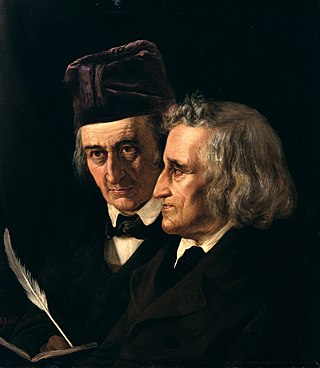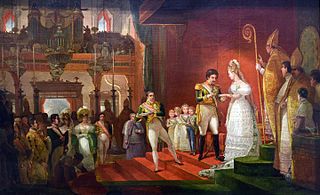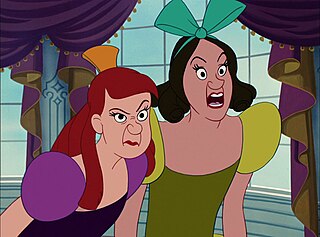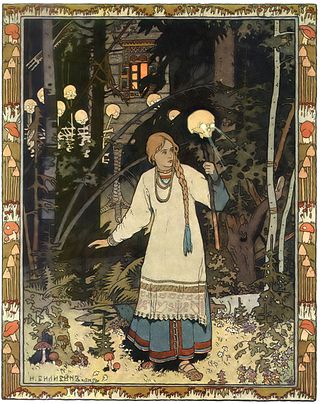Related Research Articles

The Brothers Grimm, Jacob (1785–1863) and Wilhelm (1786–1859), were German academics who together collected and published folklore. The brothers are among the best-known storytellers of folktales, popularizing stories such as "Cinderella", "The Frog Prince", "Hansel and Gretel", "Little Red Riding Hood", "Rapunzel", "Rumpelstiltskin", "Sleeping Beauty", and "Snow White". Their first collection of folktales, Children's and Household Tales, began publication in 1812.
"Cinderella", or "The Little Glass Slipper", is a folk tale with thousands of variants that are told throughout the world. The protagonist is a young girl living in forsaken circumstances that are suddenly changed to remarkable fortune, with her ascension to the throne via marriage. The story of Rhodopis, recounted by the Greek geographer Strabo sometime between 7 BCE and 23 CE, about a Greek slave girl who marries the king of Egypt, is usually considered to be the earliest known variant of the Cinderella story.
A stepfamily is a family where at least one parent has children who are not biologically related to their spouse. Either parent, or both, may have children from previous relationships or marriages. Two known classifications for stepfamilies include "simple" stepfamilies, where only one member of the family's couple has a prior child or children and the couple does not have any children together, and "complex" or "blended" families, where both members of the couple have at least one child from another relationship.

A stepmother, stepmum or stepmom is a non-biological female parent married to one's preexisting parent. Children from her spouse's previous unions are known as her stepchildren. A stepmother-in-law is a stepmother of one's spouse.

"Beauty and the Beast" is a fairy tale written by French novelist Gabrielle-Suzanne Barbot de Villeneuve and published in 1740 in La Jeune Américaine et les contes marins. Her lengthy version was abridged, rewritten, and published by French novelist Jeanne-Marie Leprince de Beaumont in 1756 in Magasin des enfants to produce the version most commonly retold. Later, Andrew Lang retold the story in Blue Fairy Book, a part of the Fairy Book series, in 1889. The fairy tale was influenced by Ancient Greek stories such as "Cupid and Psyche" from The Golden Ass, written by Lucius Apuleius Madaurensis in the second century AD, and "The Pig King", an Italian fairytale published by Giovanni Francesco Straparola in The Facetious Nights of Straparola around 1550.

A villain is a stock character, whether based on a historical narrative or one of literary fiction. Random House Unabridged Dictionary defines such a character as "a cruelly malicious person who is involved in or devoted to wickedness or crime; scoundrel; or a character in a play, novel, or the like, who constitutes an important evil agency in the plot". The antonym of a villain is a hero.

An aunt is a woman who is a sibling of a parent or married to a sibling of a parent. Aunts who are related by birth are second-degree relatives. Alternate terms include auntie or aunty. Children in other cultures and families may refer to the cousins of their parents as aunt or uncle due to the age and generation gap. The word comes from Latin: amita via Old French ante and is a family relationship within an extended or immediate family.

In fairy tales, a fairy godmother is a fairy with magical powers who acts as a mentor or parent to someone, in the role that an actual godparent was expected to play in many societies. In Perrault's Cinderella, he concludes the tale with the moral that no personal advantages will suffice without proper connections.

A cousin is a relative that is the child of a parent's sibling, this is more specifically referred to as a first cousin.

Gregory Maguire is an American novelist. He is the author of Wicked: The Life and Times of the Wicked Witch of the West, Confessions of an Ugly Stepsister, and several dozen other novels for adults and children. Many of Maguire's adult novels are inspired by classic children's stories. Maguire published his first novel, The Lightning Time, in 1978. Wicked, published in 1995, was his first novel for adults. Though unsuccessful at first, it was adapted into a popular Broadway musical in 2003.
Iullus Antonius was a Roman magnate and poet. A son of Mark Antony and Fulvia, he was spared by the emperor Augustus after the civil wars of the Republic, and was married to the emperor's niece. He was later condemned as one of the lovers of Augustus's daughter, Julia, and killed himself.

A parent-in-law is a person who has a legal affinity with another by being the parent of the other's spouse. Many cultures and legal systems impose duties and responsibilities on persons connected by this relationship. A person is a child-in-law to the parents of the spouse, who are in turn also the parents of those sibling-in-laws who are siblings of the spouse. Together, the members of this family affinity group are called the in-laws.

The ugly stepsisters are characters in the fairy tale and pantomime, Cinderella. They are the daughters of Cinderella's wicked stepmother, who treat her poorly. The "ugly stepsisters" have been in variations of the story from as early as researchers have been able to determine.

Sibling rivalry is a type of competition or animosity among siblings, whether blood-related or not.

Vasilisa the Beautiful or Vasilisa the Fair is a Russian fairy tale collected by Alexander Afanasyev in Narodnye russkie skazki.

The youngest son is a stock character in fairy tales, where he features as the hero. He is usually the third son, but sometimes there are more brothers, and sometimes he has only one; usually, they have no sisters.

The false hero is a stock character in fairy tales, and sometimes also in ballads. The character appears near the end of a story in order to claim to be the hero or heroine and is usually of the same sex as the hero or heroine. The false hero presents some claim to the position. By testing, it is revealed that the claims are false, and the hero's true. The false hero is usually punished, and the true hero put in his place.

Family is a group of people related either by consanguinity or affinity. It forms the basis for social order. The purpose of the family is to maintain the well-being of its members and of society. Ideally, families offer predictability, structure, and safety as members mature and learn to participate in the community. Historically, most human societies use family as the primary purpose of attachment, nurturance, and socialization.
An uncle is usually defined as a male relative who is a sibling of a parent or married to a sibling of a parent. Uncles who are related by birth are second-degree relatives. The female counterpart of an uncle is an aunt, and the reciprocal relationship is that of a nephew or niece. The word comes from Latin: avunculus, the diminutive of avus (grandfather), and is a family relationship within an extended or immediate family.
Fairy tale parody is a genre of fiction that parodies traditional fairy tales. The parodies are often created as new literary stories, movies, or television shows.
References
- ↑ MMeyer, Robert (2001). The Child Clinician's Handbook. p. 515.
- ↑ The Annotated Classic Fairy Tales, p. 230
- ↑ Bond, Paul (7 June 2009). "Q&A: Dan Povenmire". Hollywood Reporter. Retrieved 2009-08-26.